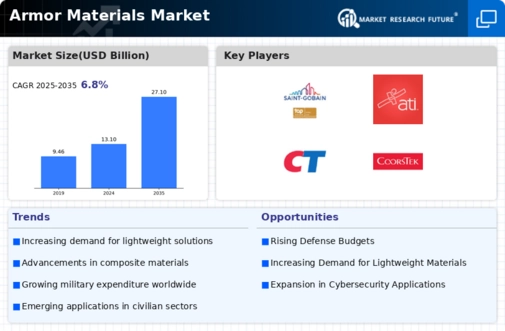Market Analysis
In-depth Analysis of Armor Materials Market Industry Landscape
The trajectory of the armor materials industry, on the other hand, results from a complex interaction among several factors that shape its dynamics. The need for advanced armor materials has been driven by countries, governments and defense organizations who prioritize their military capabilities’ enhancement; this has led to an increase in demand on such items. Thus, due to growing incidents of asymmetric warfare, terrorism and geopolitical tensions more effective protections are needed. Consequently, research has become more diversified within the protective clothing industry thereby giving rise to innovation in ceramics, composites and high performance alloys.
Moreover, global defense spending significantly influences armor material markets dynamics. Worldwide countries tend to commit substantial budgets toward military modernization with emphasis on upgrading personal protection equipment as well as vehicle armoring systems (Armour). Market growth is mainly determined by continuous technological advancements alongside competition for improved strength-to-weight ratio in material development. Besides, hybrid warfare or any other non-traditional threats call for versatile armor materials capable of resisting different forms of attacks.
Commercial use of armor materials also affects market dynamics, beyond military applications. They can be applied in other areas such as law enforcement, personal protection equipment and the automobile industry among others. This has led to adoption of advanced body armors for various non-military uses, owing to increased safety and security concerns in civilian spaces. Furthermore, the diversification into different uses further stimulates growth in the market for armor materials thereby leading to new prospects for manufacturers and researchers.
Market dynamics are characterized by technological advancements in manufacturing processes and material science. The current research is targeted at cost-effectiveness and scalability of advanced armor materials that will make them more accessible with a broader range of applications. Additive manufacturing, nanotechnology, and innovative composite formulations dominate these trends making it possible to develop lighter, stronger yet cheaply affordable solutions for armoring.
The market dynamics is influenced by regulatory issues as well as international collaboratins. Government regulations have been critical towards guiding the direction that the industry should take owing to stringent safety standards imposed on it by governments. These latter are manifest through defense partnerships aimed at sharing expertise or resources which influence how things work out globally regarding this line of business.








Leave a Comment